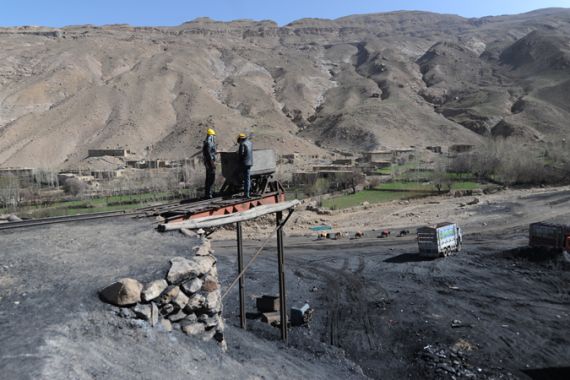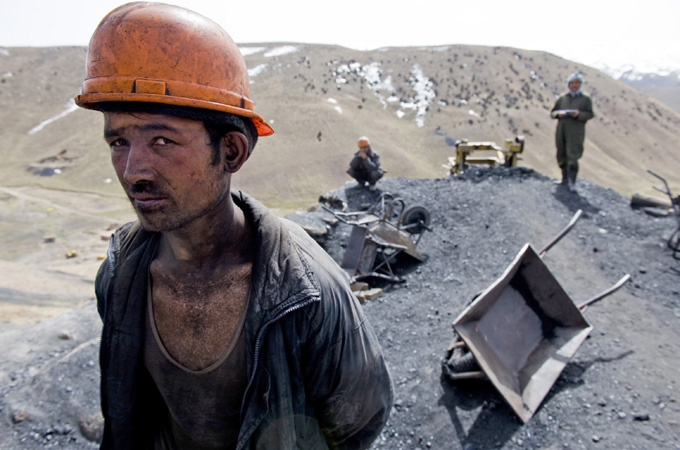Afghan mines among world’s most dangerous
Afghanistan has huge mineral deposits, but the underground wealth is unlikely to enrich vulnerable workers.

Kabul, Afghanistan – When residents near the Abkhorak mine in northern Afghanistan heard of the coal mine’s collapse, they immediately rushed to free the 57 miners trapped beneath the debris.
Lacking the necessary equipment – shovels, pick-axes and masks – they began to dig through the rubble and debris with their bare hands. Within hours of the collapse, 20 of the civilian rescuers found themselves choking from the dirt and fumes released into the air.
The Saturday afternoon collapse in the Ruyi Du Ab district of Samangan province served as yet another reminder of the dangers inherent in Afghanistan’s mining sector, often thought to be one of the nation’s last great economic hopes.
For Shoaib Alami, whose company won two mining contracts in the eastern province of Ghazni, Saturday’s collapse in Samangan immediately brought to mind an incident only 300 metres from his company’s gypsum mine.
“Three people were trapped under the rocks after an explosion,” Alami told Al Jazeera.
 |
| Afghan coal-miners in Herat province in west Afghanistan [EPA] |
Unlike his own facilities, and Abkhorak, the site of the explosion was in one of the country’s many, small, illegally operated facilities.
Though Alami said safety and security were among the chief concerns of legitimate operations, Javed Noorani, a researcher at Integrity Watch Afghanistan, said illegal mines rarely pay heed to matters of safety or environmental impacts.
The explosion described by Alami is a standard occurrence of illegally operated mines, which are often makeshift structures created by blasting mountainsides indiscriminately, said Noorani.
For the miners, working one of several shifts in a 24-hour period, collapse is not the only threat they face.
Shoddy construction
The structures hanging above them – often supported by simple wooden frameworks – are also susceptible to catching fire.
With some holes barely able to fit one or two people, the 30-40 metre depths only further the difficulty of reaching workers trapped beneath rock or flames, said Noorani.
These are ad-hoc operations excavating at exponential rates
In a nation where nine million people live on less than one dollar per day, the workers are left with little choice but to accept the dangers that come with work in both government-sanctioned and illegal mines, Herve Nicolle, co-director of Samuel Hall, a Kabul-based research organisation, told Al Jazeera.
Though Alami said he has made a concerted effort to hire people from within Ghazni to work in the limestone and gypsum mines, illegal operations, which he estimates constitute 60-75 percent of Afghanistan’s mining sector, make it especially difficult for government-contracted mines to hire from within the community.
Both Alami and Noorani describe the illegally operated mines as being run in a mafia-like atmosphere, led by local strongmen, commanders of armed groups and corrupt parliamentarians.
Alami said operations like his, despite being held to specific government standards of safety and environmental impact, often pay double the rate of the illegal mines; but are still at a competitive disadvantage.
“These strongmen use guns and fear to force people to work for them,” he told Al Jazeera.
Where the government-sanctioned mines do have the upper hand, said Alami, is in quality control.
“These are ad-hoc operations excavating at exponential rates, how could they sell high quality goods?”
Organised crime involved
Though Afghanistan’s mineral deposits are estimated to be worth trillions of dollars, Noorani said copper and gemstones, which are most likely to have been illegally excavated, are sold at a pittance to Pakistan by the “large mafia” that runs much of the illegal mining in the nation.
Coal and gemstones mined in Samangan and Takhar provinces, in the north, are brought to the capital, where they are sold to illegal traders in Deh Sabz district who then transport the minerals to the Torkham border and eventually into Pakistan.
When told of the low prices Afghan minerals are sold to Pakistan for, Noorani said Kabul often reply that their hands “are tied” by the force and complicity of militia leaders and parliamentarians.
Dangers associated with mining, however, are not limited to far-flung corners of the nation.
In Damana Kamari, a 40-minute drive from Kabul City, Nicolle said most of the people in the community of 4,000 work in the mining sector.
A relatively stable income of 300 to 350 Afghanis – six to seven dollars – per day, has also drawn people from nearby eastern provinces to the village.
Though Logar, an hour from the capital, is home to the Mes Aynak – the world’s second-largest copper deposit – Nicolle said he saw dozens of Logaris who had left the eastern province to work in the mines of Damana Kamari.
With Logar cited as one of the poorest and most insecure provinces in the country, the Logaris had hoped the $20 per truck made by the stone mines would improve their financial situation – while also shielding them from armed resistance groups.
|
|
| Afghan war economy boom ‘about to burst’ |
But with an estimated 20 “accidental deaths” here in the past three years alone, Nicolle said the people were not blind to the risks they were taking.
The miners may have placed their hopes in their nation’s mineral wealth, but even large reserves and purported high quality goods have done little to curb Nicolle’s scepticism about the impact of mining on the daily lives of the nation’s 32 million people.
With oil production having begun last year, Nicolle said he has seen people who think they will “no longer have to go to petrol stations, because gas will be free”.
What those placing their hopes in minerals fail to acknowledge, is that “you need a lot of conditions for the money to reach beyond the low-level workers”, said Nicolle.
With Afghanistan ranked 174 out of 176 countries in Transparency International’s 2012 corruption perception index, Nicolle said there was very little evidence that the three trillion dollar value of the nation’s 1,400 mineral fields will have a meaningful impact on the economy of the entire country.
Follow Ali Latifi on Twitter: @alibomaye